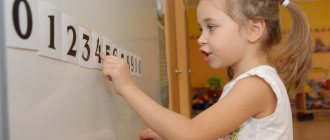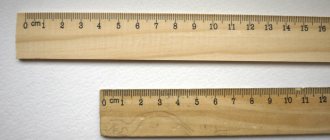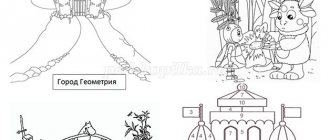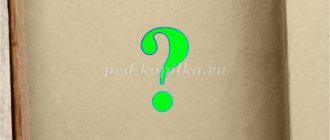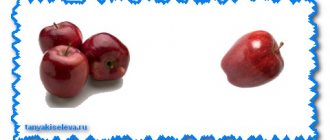Mastering the second ten numbers
Explaining to a child in an accessible form how to obtain numbers greater than 10 is not always easy. First, it is important to master mental counting to 20, to show your child how to write all the numbers he has learned. The question of why and why 7+4 is written as 11 will definitely arise. It is important to explain on paper that for convenience, large numbers are counted by 10. Adding 7 and 3 is ten, but you need to add 4, that is, one is missing. It turns out that the result is 7 + 3 and one more, that is, 11.
Another visual exercise can be done with nuts, candies, and construction kit parts. You should count 15 items and write down their number in numbers. Then decompose them into 10 and 5 and show that ten in a two-digit count is written as one, and 5 is the number of ones. It is also worth doing by counting 20 objects and showing that it includes 2 tens, and the number 21 is the same, plus one more.
Development of mathematical concepts. Composition of a number of units (number 10)
Senior group No. 2
Objectives: 1. Improve knowledge about composing a number from units (the number 10). 2. Fasten:
- ordinal and quantitative counting;
- ideas about the immutability of numbers as a result of changes in the way objects are placed in space;
- knowledge about temporary relationships: week, month.
Demonstration material: 10 figurines of birds and animals. Handouts: small toys: nesting dolls, flowers.
Progress of the lesson
Children stand in front of a board, on which the teacher places animals in a row and reads a poem.
We walked at the zoo and counted the animals. This is a bird, this is an animal, Exactly ten of them, check.
Children count animals and birds and tell the teacher how many there are.
One is a cheerful parrot, Two is a panther. Do not snooze! Three is a mischievous monkey, And four is a miracle bird. Behind the peacock is a lion - he is the fifth. Six – striped tiger cub. Seven - a seal swims in the water. Eight is a reindeer. The bear cub is nine, and the tenth is a swan.
- How many birds are there in total? — How did I make up the number 10? - What is the value of a lion? Seal? Teddy bear? - Who is fourth? Sixth? Tenth? — Shall we now count the animals and birds in order?
The teacher thanks the children and invites them to go to the tables on which small toys lie.
— Place in front of you 1 more nesting dolls than 5. — Now let’s make it so that there are 7 nesting dolls. — Now, boys, take 5 flowers. How many flowers did you take? — Give these flowers to the girls. - Girls, how many flowers did the girls give you? Has the number of colors changed? Why? — Return these flowers to the boys. — Boys, how many flowers did the girls give you? Has the number of colors changed? Why?
Children conclude that the number of objects does not change as a result of their movement. The teacher thanks the children and reinforces with them the names of the days of the week.
— Did I forget what day of the week it is? - What will it be like tomorrow? — What day of the week was yesterday? — What day of the week do you not go to kindergarten? — Let us repeat with you the poem with movements:
I did the laundry on Monday, Paul swept on Tuesday. On Wednesday I baked a loaf of bread, I spent all Thursday looking for a ball, I washed the cups on Friday, and on Saturday I bought a cake. I invited all my girlfriends to my birthday party on Sunday.
Next, the teacher reinforces with the children the knowledge of the months of the year.
— What time of year is it now? What month? - What month does the year begin with? - Which month is the hottest? — Name the last month of the year. — Name the second month of autumn. - Name the third month of spring. — What month comes after October?
The teacher thanks the children for their work.
I used fiction, poems by N. Vladimirov, P. Bashmakov.
Fun and effective learning to count
In the company of loving parents, learning to count and form numbers turns into an exciting activity. In order for the child to be able to assimilate and clearly appreciate everything that the elders explain, you will need:
- counting sticks;
- scores (they can be attracted by playing shop);
- cubes;
- homemade cards;
- number houses;
- toys or candy;
- buttons of different colors.
Lesson 1: concept of number composition
The abacus will help you learn all the numbers.
You can use them while playing shop. Toys, children's dishes, cubes, and other identical household items will help develop a child's interest in mathematics. The study begins with the number 2, asking the child to put a cube on the table and specifying what needs to be done to make two of them. Usually a 5-6 year old child is able to guess what is going on. A younger child can be given a hint.
The exercise should be reinforced using other objects. It is important for the child to remember that the number 2 in any case includes two units, regardless of what items make it up (2 cans, 2 books, 2 pieces of soap, and so on). Let him place on the table 2 items that he likes (pebbles, cubes, berries, chestnuts or nuts).
- lay out 3 coins one at a time (at different distances or “in a column”);
- add one to two coins (put two coins together, and one at a distance);
- add two to one coin.
After the child has mastered the “three” (understands that three coins together is the same as two coins with one, and has practiced putting them together), you can teach the number 4 in a playful way. Checkers and a board will help here. You should invite the little student to place 4 white checkers on the board, and then ask the question: how many checkers will remain if you replace one white checker with a black one? How many of them will there be in total if you line up 2 white and 2 black checkers? It is important for the child to understand that the number 4 will be obtained with any rearrangement.
Involving a preschooler in solving everyday problems will help teach the correct composition of numbers. For example, ask him to lay out the forks for a family dinner. First, you can give him one device and ask how many more he needs for the family. After thinking, the child will be able to give the correct answer. Studying the cards together will also allow you to quickly master the composition of the number.
Lesson 2: working with cards
You can easily make cards with numbers yourself.
At this stage, it is important to connect 2 types of cards (purchased or made yourself). It is desirable that in the first version they consist of two halves. An object can be drawn on one side, and 2,3,4,5 or more copies of it on the other. The halves can be united by a “+” sign, or it can be done separately.
The second version of the cards is a set of pictures where objects are depicted as a single set, without division. When your child can match numbers and numbers, you can make a third set of cards with digital images. There should be enough cards so that he can imagine the same number in different versions (for example, 5 is 1 and 4, 2 and 3, 3 and 2, 4 and 1).
Lessons with cards are held in a relaxed manner. The child should be shown a card that shows, for example, 6 snowflakes and asked to collect the same number of snowflakes from the proposed pictures. It is important to switch roles sometimes. The child gives adults tasks, corrects their intentional mistakes, and learns to control the actions of other people. Similar work is being done with digital cards. The child must learn to select several options for the composition of the proposed number.
Lesson 3: connecting number houses
Number houses can be drawn in a notebook or made from colored paper; the child will put the necessary cards with numbers in the windows of the house.
Number houses help strengthen mental counting skills. They are presented in textbooks, but you can draw pictures yourself. Each house has a roof and several apartments located in 2 rows. The height depends on the number to which the combinations are selected. For example, for a double, 2 floors are enough (1+1, 2+0), for a triple, 3 (1+2.2+1.3+0) and so on.
You can draw houses with your child, showing at the same time why and how to fill them. A number from 2 to 10 is written in a triangle on the roof. The child is explained that there are as many residents living in two apartments on the same floor as indicated on the roof (for example, 5 residents). Let one person live in one of the apartments on the lowest floor, then with the help of counting sticks the kid determines that there are 4 residents in the second one.
As the child climbs the floors and populates them, he will determine the composition of the pairs (1 and 4, 2 and 3, 3 and 2, 4 and 1). To consolidate the result, you can hang sheets of houses around the apartment so that the child learns to fill them in with a pencil. When the baby masters composition 10, you can move on to a more complex program.
Options for number houses that can be easily printed or made by analogy:
Option 2:

